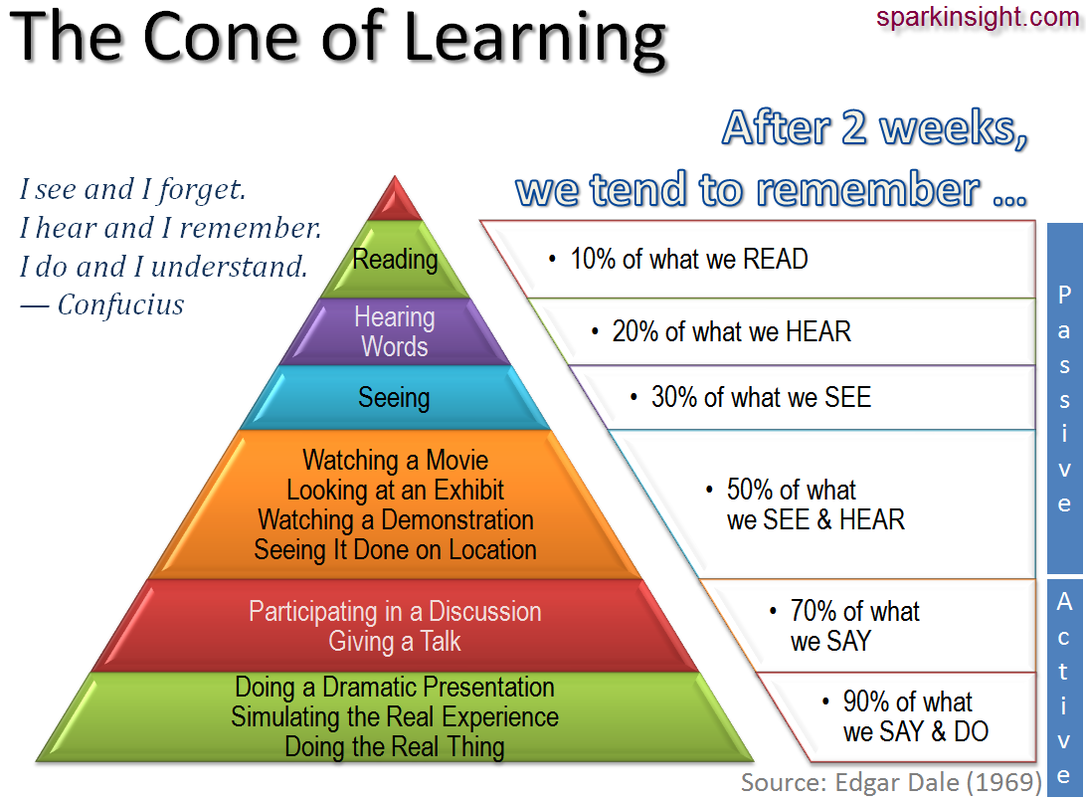This is the famous "Dale Cone of Learning." Edger Dale was a teacher who was interested in the application of visual aids in teaching. His interest in film led to a position with Eastman Kodak as a member of the editorial staff of Eastman Teaching Films.

It was originally called "The Cone of Experience" and appeared in a textbook on audiovisual teaching methods. Interestingly, there was no research basis for the "cone" and no numbers; the numbers seem to have been applied later by one D.G. Treichler, a Mobil oil company employee writing a visual aids article.
The original labels for Dale’s ten categories are: Direct, Purposeful Experiences; Contrived Experiences; Dramatic Participation; Demonstrations; Field Trips; Exhibits; Motion Pictures; Radio; Recordings; Still Pictures; Visual Symbols; and Verbal Symbols.
When Dale researched learning and teaching methods he found that much of what we found to be true of direct and indirect (and of concrete and abstract) experience could be summarized in a pyramid or ‘pictorial device’ Dales called ‘the Cone of Experience’.
In his book ‘Audio visual methods in teaching’ – 1957, he stated that the cone was not to be taken literally. It was merely designed as a visual aid to help explain the interrelationships of the various types of audio-visual materials, as well as their individual ‘positions’ in the learning process. This was all quite intuitive and virtually research-free.
He said “The cone device is a visual metaphor of learning experiences, in which the various types of audio-visual materials are arranged in the order of increasing abstractness as one proceeds from direct experiences”
In a way, this is reminiscent of the surprising evolution of the tests devised by Alfred Binet and his colleague Theodore Simon. They began developing questions that focused on things not explicitly taught in schools, such as attention, memory, and problem-solving skills. Using these questions, Binet determined which ones served as the best predictors of school success.
It became something quite different.

It was originally called "The Cone of Experience" and appeared in a textbook on audiovisual teaching methods. Interestingly, there was no research basis for the "cone" and no numbers; the numbers seem to have been applied later by one D.G. Treichler, a Mobil oil company employee writing a visual aids article.
The original labels for Dale’s ten categories are: Direct, Purposeful Experiences; Contrived Experiences; Dramatic Participation; Demonstrations; Field Trips; Exhibits; Motion Pictures; Radio; Recordings; Still Pictures; Visual Symbols; and Verbal Symbols.
When Dale researched learning and teaching methods he found that much of what we found to be true of direct and indirect (and of concrete and abstract) experience could be summarized in a pyramid or ‘pictorial device’ Dales called ‘the Cone of Experience’.
In his book ‘Audio visual methods in teaching’ – 1957, he stated that the cone was not to be taken literally. It was merely designed as a visual aid to help explain the interrelationships of the various types of audio-visual materials, as well as their individual ‘positions’ in the learning process. This was all quite intuitive and virtually research-free.
He said “The cone device is a visual metaphor of learning experiences, in which the various types of audio-visual materials are arranged in the order of increasing abstractness as one proceeds from direct experiences”
In a way, this is reminiscent of the surprising evolution of the tests devised by Alfred Binet and his colleague Theodore Simon. They began developing questions that focused on things not explicitly taught in schools, such as attention, memory, and problem-solving skills. Using these questions, Binet determined which ones served as the best predictors of school success.
It became something quite different.
No comments:
Post a Comment